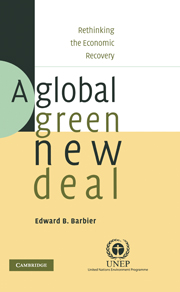Book contents
- Frontmatter
- Contents
- List of figures
- List of tables
- List of boxes
- Foreword
- Preface
- Acknowledgements
- Part I Why a Global Green New Deal?
- Part II The Key Components of a Global Green New Deal
- Part III The Role of the International Community
- Part IV Towards a Greener World Economy
- Appendix 1 PIIE–WRI analysis of a green recovery program for the United States
- Appendix 2 Pew comparative analysis of clean energy jobs and investments in the United States, 1998–2007
- Glossary
- Index
Preface
Published online by Cambridge University Press: 05 June 2012
- Frontmatter
- Contents
- List of figures
- List of tables
- List of boxes
- Foreword
- Preface
- Acknowledgements
- Part I Why a Global Green New Deal?
- Part II The Key Components of a Global Green New Deal
- Part III The Role of the International Community
- Part IV Towards a Greener World Economy
- Appendix 1 PIIE–WRI analysis of a green recovery program for the United States
- Appendix 2 Pew comparative analysis of clean energy jobs and investments in the United States, 1998–2007
- Glossary
- Index
Summary
On December 2 and 3, 2008, the United Nations Environment Programme (UNEP) convened a consultative meeting of policy experts in Geneva, under the auspices of its Green Economy Initiative (GEI), to outline possible proposals for a “Global Green New Deal.” To participants in that meeting, the need for such a comprehensive global strategy was self-evident: the world was confronted with multiple crises – fuel, food and financial. By December 2008 it was already apparent that the result of these crises would be one of the worst global economic recessions since the Great Depression of the 1930s. The multiple crises threatening the world economy therefore demanded the same kind of initiative that had been shown by the New Deal of US president Franklin D. Roosevelt in the 1930s, but at the global scale and embracing a wider vision. Such a vision would require finding the right mix of policy actions to help stimulate recovery and create jobs while also improving the sustainability of the world economy, enhancing the livelihoods of the world's poor and channeling investments into dynamic economic sectors and at the same time lessening carbon dependency and environmental degradation. The phrase “Global Green New Deal” (GGND) refers to such a timely combination of policies.
- Type
- Chapter
- Information
- A Global Green New DealRethinking the Economic Recovery, pp. xvi - xxPublisher: Cambridge University PressPrint publication year: 2010



